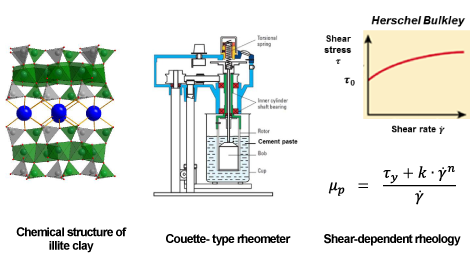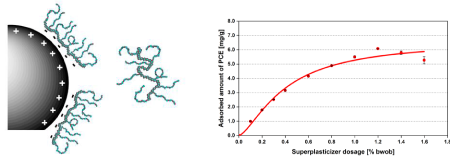25. Shear-Dependent Rheological Behavior of Ecologically Improved Cements Containing Calcined Clays as Clinker Substitute
Principal investigator(s) – PI
- Prof. Dr. Johann Plank
Technische Universität München, Lehrstuhl für Bauchemie
Researcher(s) in-charge – RI
- M. Sc. Na Miao
Technische Universität München, Lehrstuhl für Bauchemie
- M.Sc. Li Ran
Technische Universität München, Lehrstuhl für Bauchemie
Researcher(s) associated – RA
- Dr. Lei Lei
Technische Universität München, Lehrstuhl für Bauchemi
Project Description
The significant CO2 footprint of cement can be reduced considerably through substitution of clinker with pozzolanic materials. Calcined clays (CCs) are considered as the most promising substitution material, however, depending on the composition of the natural raw clay which always presents a mixture of different clay minerals, various effects can occur in cement, this study aims to self-prepare four different calcined clays (meta kaoline, meta montmorillonite, meta illite and meta muscovite) of high pozzolanic activity via calcination, to characterize them and to evaluate their impact on the rheology of suspensions of these pristine clays or OPC-CC 70:30 blends. Furthermore, the calcined clay blended cement provided by the Central Project will be included as a reference material in all tests.
By using a Couette-type rotational viscometer, especially their shear-dependent viscosity will be determined and corresponding rheological key parameters such as plastic and apparent viscosity, yield stress, gel strengths etc. will be captured and the overall behavior of the fluid (shear-thinning or shear-thickening) shall be ascertained. Moreover, the rheograms will be fitted to known rheological models including Power law, Bingham, Herschel-Bulkley etc.

Furthermore, all systems will be admixed with four self-synthesized and well characterized superplasticizers (= dispersants), namely 2 polycarboxylates, 1 polyphosphate-carboxylate and 1 polycondensate, to understand the interaction of the calcined clays with such dispersants and to assess their behavior in practical applications such as during mixing, transport, pumping, in 3D printing etc. In cooperation with TU Braunschweig (Prof. Lowke) the time and shear rate dependent disagglomeration of our OPC/CC composite cement particles and of the low clinker composite cement provided by the SPP upon addition of superplasticizer will be tracked by employing an FBRM instrument.

Interaction of PCE superplasticizers with calcined clay via surface adsorption
Mechanistically, the build-up of the electrochemical double layer on the surface of the CC particles will be determined via zeta potential measurements and adsorption isotherms will be developed which could indicate whether the dispersants preferentially adsorb on cement or on CC. The overall aim of the study is to provide an understanding of the shear-dependent rheological behavior of pure, individual calcined clays at the micro and nano levels as a basis for future studies to be conducted at the macro level (concrete). Additionally, by understanding the behavior of individual pure calcined clays the properties in mixtures which typically occur in CCs prepared from natural clay deposits can be predicted better.
Publications
Data in Brief 39 (2021)
Applied Clay Science 207 (2021)
Cement and Concrete Composites 133 (2022)
